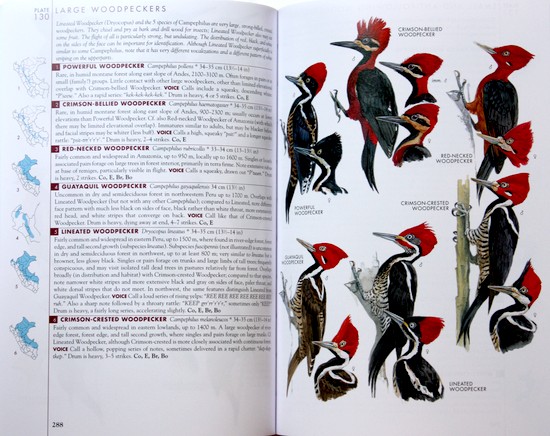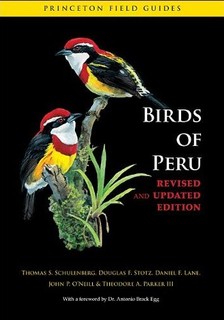Reviewed by Grant McCreary on June 23rd, 2010.
Peru is a birder’s paradise. With over 1800 species, it is second only to Columbia in terms of bird diversity. And new species are still being discovered! Thus, it is vital that the country have an excellent field guide. And it does.
Frank Lambert has already written a great, detailed review of the first edition of this field guide. I won’t attempt to cover the same ground, since he has a much greater expertise and experience with neotropical birds than I do. Instead, I’ll provide an overview of the guide, some general impressions, and how this “revised and updated” edition differs from the prior one.
The guide follows a fairly standard format of illustrations on the right-hand page with text and maps on the left. The illustrations, paintings provided by several artists, are labeled with the species name. The sex, age, and subspecies name are indicated where appropriate.
The maps are all lined up on the far left-hand side. The species accounts contain:
- Length – in centimeters and inches (bravo!); wingspan where appropriate
- Geographic Variation – an * next to the name indicates that there are two or more subspecies (across the entire range)
- Relative Abundance – common, uncommon, etc
- Habitats
- Behavior
- Elevational Distribution
- Voice
- Regional Distribution – indicates the countries surrounding Peru where the species is also present, or if it is a Peruvian endemic

The illustrations are attractive and, given the number of artists, fairly consistent. Thankfully, the plates haven’t been crammed full of tiny birds, like some neotropical guides. On average, there are about six birds per plate, and the illustration sizes are about right (with some outliers, of course). The labeling and layout are generally intuitive and well done. Still, there are some plates where I was confused as to which illustration belonged to which species. Finally, the only other thing I could wish for would be annotated arrows pointing to field marks, a la the Sibley and Collins guides. It appears that there is actually enough room for them on these plates.
The maps are also quite helpful, using seven different colors to indicate a bird’s range within the country. The department (state) boundaries and some major rivers are shown, thankfully. I found nothing to complain about concerning the handling of the maps.
There is not enough room for an extensive species account. Thus, the text focuses on that which will assist in field identification. Still, the authors were able to include a good bit of information. I was especially pleased to see relative abundance and elevational information included.
Subspecies identification and distribution are critical in the neotropics, where many of them are likely to be elevated eventually to full species. Birds of Peru does a decent job illustrating and discussing field-identifiable subspecies that occur within the country. However, in the case where there is only one subspecies found in Peru, I would have liked the subspecies name to be given. The asterisk indicating geographic variation is a step in the right direction, but I think the actual name would have been much more useful.
Changes in the Revised Edition
I don’t have the previous edition, so I cannot make a direct comparison. But here are the changes that I’m aware of.
The most obvious change is in the binding – from a jacketless hardcover to paperback. This change will obviously lighten the guide somewhat, making it more portable. But I don’t know how much of a practical difference this actually makes. The new binding seems like it would be fairly durable.
This revised guide includes an additional 25 species not covered in the first. Most have been found in Peru for the first time since the first edition’s cutoff date, but some are the result of taxonomic splits and at least one is an entirely new species discovered recently. 21 of these birds are grouped together on three plates appended to the end of the guide’s main section. The others, I believe all a result of splits, are included in the main body of plates.
Recommendation
Birds of Peru is a field guide worthy of the country it covers. However, if you have no plans to bird in Peru or nearby regions and have no interest in neotropical birds, then you have no reason to get this field guide (if that’s you, why are you reading this?). Likewise, if you have the previous edition and aren’t planning to visit Peru anytime soon, then there is not a compelling reason to upgrade. But everyone else should have a copy of this commendable guide. And if you’re lucky enough to be birding in Peru, you’d be crazy not to have this with you.
Disclosure: I get a small commission for purchases made through links in this post.
Disclosure: The item reviewed here was a complementary review copy provided by the publisher. But the opinion expressed here is my own, it has not been influenced in any way.





[…] you’d like a more in-depth look at this excellent field guide, I’ve written a full review at The Birder’s Library. Tags: Peru If you enjoyed this post and would like to receive updates from this blog, please […]
I use the first edition of “Birds of Peru” often since I live in Peru. As you said, it is a field guide worthy of the country it covers. I did not know a second edition was on the market since I live in the ‘out-back’ and do not get to Lima often. I will look for it.
The art work is outstanding. I have found several hundred species in my area and the art is always very accurate when compared with the actual bird, especially the difference between male and female.
I owned several bird books in the States, but none of them compare to this field guide in accuracy.
I do disagree with one statement you made: I think ‘birders’ would enjoy this book even if they do not live in Peru. A great many of the species fly north for the northern summer and return to Peru during the northern winter. I have several marlins who stay for a few months and then fly north, as well as several other species. Many of the birds, especially hawks, in the book can be seen in North America. It might be worth the investment to a serious bird watcher as well as give a better understanding of how birds move and where they live during the year.
Thanks for your review.
Sincerely,
James Clifford
Pacchilla, Peru
Yes, why would anyone read this if they don’t have the interest in neotropical birds,
Why even write that.